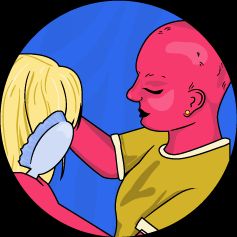Hair loss doesn’t discriminate as much as you might think. Both men and women experience it for a variety of reasons. If your mane is looking a little less full than usual, don’t panic. Depending on the cause, there are different steps you can take to repair the damage.
More than half of men over 50 will experience androgenic alopecia, aka male pattern baldness. It’s characterized by a weakening and shrinking of the hair follicles, which produce finer strands of hair with each growth cycle until, eventually, the hair just stops growing.
Whether or not you’ll be affected by male pattern baldness has a lot to do with genetics, family history, and the male sex hormones called androgens.
Keep in mind…
Conditions like cancer, nutritional and thyroid problems, certain medications, and nutritional disorders can contribute to hair loss, so check in with your doctor if you’re experiencing any other symptoms or recently started taking a new medication.
Female pattern baldness, or androgenetic alopecia, is hereditary, but more likely to kick in after menopause due to hormone fluctuations. The majority of women will experience some kind of hair loss after menopause.
Compared to men, women will lose their hair in a different pattern, and far fewer will experience total baldness. Women should reach out to a doctor or dermatologist if they notice their hair starting to thin, in order to rule out any other medical conditions.
For men with male pattern baldness, hair loss usually starts on the crown of the head or around the temples. What happens next is up to the hair gods: Some men may experience a continually receding hairline, others may have one that recedes into an “M” shape, and some men will just get a single bald spot.
Often, male hair loss is just cosmetic and requires no medical interference. That doesn’t mean it doesn’t feel like a bummer.
For those who would rather not embrace their new look, there are hairstyles, hair pieces, and wigs that can make things a little less obvious. There are also medications and other procedures available if you’re looking for a more permanent solution (more on those later).
Whether hair loss runs in your family or you just want to strengthen the hair you’ve got, there are some totally natural and non-medical ways to protect your mane.
Eat right: Some research suggests that eating a diet rich in protein can prevent hair loss, which makes sense seeing how hair follicles are made of a protein called keratin.
Another study found that the Mediterranean diet could foil or at least slow the onset of both male and female pattern baldness due to its high content of raw vegetables, fresh greens, and herbs like parsley and basil.
Supplement smart: When it comes to hair growth and retention, you better know your As, Bs, Cs, and Ds … vitamins, that is. Along with iron, selenium, and zinc, these vitamins help keep and grow the hair you already have on your head by promoting cell turnover.
The retinoids that make up vitamin A also help regulate sebum production and speed up hair growth. And vitamin D has been used to treat nonscarring alopecia and help with regrowth.
There’s also biotin, otherwise known as B7 or vitamin H, which is partly responsible for synthesizing the fatty acids essential to healthy hair. A deficiency in biotin can cause thinning hair, so talk with your doctor about supplementing.
Go herbal: Ginseng has phytochemicals that may be beneficial for promoting hair growth, although the research isn’t definitive. Consult with your doctor about supplements or experiment with topical solutions that list ginseng as an ingredient.
For men, there’s also saw palmetto, a supplement derived from the fruit of small palm trees (Serenoa repens) that helps regulate testosterone levels and has been shown to improve hair growth.
Be careful with your hair care: When it comes to your everyday hair routines, make sure you’re not adding insult to hair loss injury by using harsh shampoos that strip hair of its good oils or styling it in a way that can damage it.
Tight braids and ponytails can lead to excess shedding, and you might as well go easy on the hot tools, which can encourage breakage. And while chemical dyes, perms, and straighteners may give you the cosmetic results you want, they can wreak havoc on your hair and scalp.
Research organic and less harsh alternatives to your preferred treatments, and skip out on ones that contain para-phenylenediamine, ammonia, or peroxide.
Raid your pantry: Try incorporating coconut and olive oil into your hair care routine. Research has shown that the lauric acid in coconut oil combats breakage by helping bind protein in the hair. It also helps prevent damage from sun exposure.
Olive oil is another common household healthy hair friend. Try using it as a deep-conditioning treatment to combat dryness that can lead to breakage. Just massage a couple of tablespoons of it into the hair and let it marinate (literally) for 30 minutes before rinsing.
Get oiled up: According to some research, essential oils, such as lavender and rosemary, can help combat hair loss associated with alopecia areata, an autoimmune condition that causes hair to fall out in patches.
You can DIY your own essential oil treatment at home by mixing a couple of drops of lavender, rosemary, lemongrass, or even peppermint oil into 2 tablespoons of carrier oil like olive oil or jojoba. Let that baby sit for 10 minutes before rinsing out.
Learn how to choose the best essential oils here, and always do a patch test if you’ve never used one before.
Make alliums your ally: Believe it or not, onion juice has also been shown to encourage regrowth in those with alopecia areata when applied to the scalp two times per day.
While the research is limited, scientists suspect the growth-promoting effects are linked to onions’ high sulfur content.
Show your scalp some TLC: Everyone loves a good rub down, but your scalp may love it just as much as you do. According to a small study, just a few minutes of massage every day over the course of 6 months helps improve hair growth.
Find ways to destress: When it comes to hair loss, stress isn’t doing you any favors. If your thinning mane is stress-related, certain calming yoga positions, such as Camel and Fish Pose, can help mitigate your anxiety and the less-than-favorable effect it’s having on your head — inside and out.
Kids may make you want to pull your hair out for other reasons, but you can at least try to avoid hair loss after pregnancy, aka telogen effluvium.
While relatively uncommon, this condition is caused by the stress of pregnancy, giving birth, and hormonal fluctuations. Underlying health conditions like thyroid problems can also aggravate it.
If you have telogen effluvium, it may resolve on its own. However, seek medical attention if your hair loss persists to rule out anything more serious.
When it comes to telogen effluvium, a good defense is the best offense, so here are some things you can do to protect your locks:
- Eat a balanced diet and talk with your doctor about a prenatal vitamin.
- Avoid styles that pull at your hair, like braids and tight buns.
- Check with your doctor to make sure the medications or supplements you take are hair-friendly.
- Limit harsh treatments and heat styling to a minimum.
- Don’t go ham when detangling your hair. Handle those knots gently and try using a wide-toothed comb.
- Keep calm and know that most pregnancy-related hair loss is temporary. If you’re still worried, talk with your doctor about treatment options.
For those experiencing hair loss due to chemotherapy and those who have genes to blame, low level laser treatments called red light therapy can improve hair density by stimulating epidermal stem cells. At-home devices are available to the tune of $200–$600.
If a hairpiece, wig, or hair transplant just isn’t your thing, and lifestyle hacks simply aren’t cutting it, there are other medical procedures and treatments that can help return your hair to its former glory.
Minoxidil
This over-the-counter medication is known to most as Rogaine. It’s important to note that this topical solution can have some rarer side effects, including weight gain and rapid heartbeat, but it has proven to be a very effective treatment option for some men and women.
In a study of 31 women who used Rogaine daily for at least 6 months, 83.9% reported satisfaction.
Phenylephrine
Another topical option is phenylephrine. This treatment is best suited to hair loss due to styling, since it makes the follicle muscle contract, making it harder to yank out hairs during brushing or braiding, for example.
Finasteride
You’ll need a prescription for Finasteride, aka Propecia. It works by helping slow down hair loss, but it might promote growth as well. This pill has been approved for men, and it’s more likely to be effective if you’re under 60 years of age.
It isn’t recommended for people who are or may become pregnant.
Platelet-rich plasma
If you’d prefer not to go the pill or topical route, platelet-rich plasma (PRP) injections can help encourage growth in areas where you’ve already lost some hair.
To get the plasma, your blood will be drawn and centrifuged to separate out the platelets, which are then injected into your scalp. If it sounds expensive, that’s because it is. One session can cost $1,000 and you’ll need multiple rounds to see results.
Here’s the deal: A certain amount of hair loss due to the natural lifecycle of your hair is normal — about 100 hairs per day.
However, sudden and noticeable loss, be it patchy or all over your head, is a good reason to talk with a doctor. The reasons behind it may be temporary and nothing to worry about, but it’s best to be sure and get ahead of it while you can.
Apart from genetics, stress, and certain diet and lifestyle factors, here are some other hair loss culprits to consider:
- harsh styling practices
- emotional or physical stress
- certain medications, including certain steroid treatments
- radiation treatments
- hormonal fluctuations due to pregnancy, giving birth, or menopause
- certain medical conditions, trichotillomania (hair-pulling disorder), and scalp conditions
If you’re experiencing hair loss of any kind, you’re certainly not alone. Whether you decide to live and let bald or try your hand at a treatment option or natural remedy, the choice is yours, and there are many options available.


